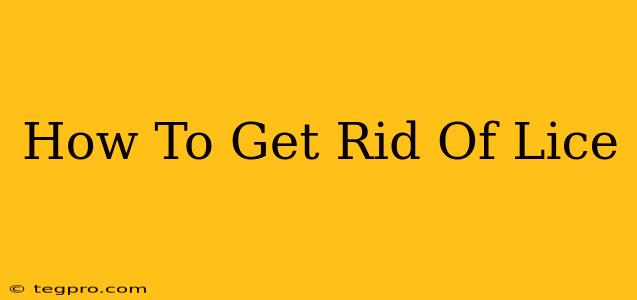Lice infestations are a common problem, affecting people of all ages and backgrounds. It's important to remember that having lice isn't a sign of poor hygiene – they are easily spread through close contact. This comprehensive guide will walk you through how to effectively get rid of lice and prevent future infestations.
Understanding Lice
Before diving into treatment, let's understand what we're dealing with. There are three main types of lice that affect humans:
- Head lice: These tiny insects live on the scalp and feed on human blood. They are the most common type of lice infestation.
- Body lice: These lice live in clothing and bedding, biting the skin to feed.
- Pubic lice (crabs): These lice infest the pubic hair and surrounding areas.
This guide primarily focuses on head lice, as they are the most frequently encountered.
Identifying a Lice Infestation
The telltale signs of head lice include:
- Intense itching: This is often the first symptom and can be quite severe.
- Visible lice: These are small, grayish-white insects that are about the size of a sesame seed. You may see them crawling on the scalp or in the hair.
- Nits (lice eggs): These are tiny, white or yellowish oval-shaped eggs firmly attached to the hair shaft, close to the scalp. They are difficult to remove and a key indicator of an infestation.
How to Get Rid of Lice: Treatment Options
Effective lice removal requires a multi-pronged approach:
1. Over-the-Counter (OTC) Lice Medications:
Many effective lice shampoos and lotions are available without a prescription. These typically contain permethrin or pyrethrin, insecticides that kill lice. Always follow the product instructions carefully, including how long to leave the product on the hair and how to thoroughly rinse. It's often necessary to repeat the treatment after several days to kill any newly hatched lice (nits that have hatched).
2. Wet Combing:
This method involves using a fine-toothed comb to physically remove lice and nits from the hair. This is often used in conjunction with OTC medications to improve effectiveness. Wet the hair thoroughly, apply a conditioner to make combing easier, and systematically comb through the hair, section by section, rinsing the comb frequently. This is a time-consuming but effective method, particularly for removing nits.
3. Prescription Medications:
If OTC treatments are unsuccessful, your doctor may prescribe stronger medications. These are usually only necessary in cases of severe infestations or resistance to OTC treatments.
Preventing Lice Infestations
Prevention is key to avoiding lice infestations:
- Avoid head-to-head contact: This is the most common way lice spread.
- Don't share personal items: This includes hats, scarves, combs, brushes, and headphones.
- Regularly check hair: Regularly inspect your hair and your children's hair for lice and nits. Early detection is crucial for effective treatment.
- Wash bedding and clothing: Wash all bedding, towels, and clothing in hot water (at least 130°F) and dry on high heat to kill any lice or nits that may be present.
- Vacuum frequently: Vacuum carpets, furniture, and car seats to remove any lice or nits that may have fallen off.
When to See a Doctor
Consult your doctor if:
- You have tried OTC treatments without success.
- You have a severe infestation.
- You experience an allergic reaction to lice treatment.
- You are concerned about the effectiveness of your treatment.
Remember, getting rid of lice requires patience and persistence. By following these steps, you can effectively eliminate lice and prevent future infestations. Early detection and a combination of treatment methods are key to successful lice removal.

